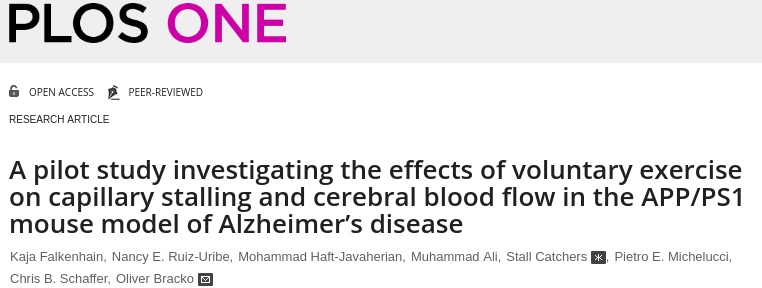Another one is out there! Earlier this we told you about the first scientific paper published with Stall Catchers data - data YOU helped generate - in Nature's Scientific Reports.
The second one is out too - in PLoS One!:

As you can see, Stall Catchers - that is all of you, who contributed to the analysis of the "Running" dataset, are included in the list of authors 💜
Moreover, the research question itself was prompted by one of you in our forum!!!
You can read the full open access paper here.
In a nutshell...
You helped discover that exercise reduces some Alzheimer's symptoms in mice, but does not impact the frequency of stalls.
Here's the abstract of the paper:
Exercise exerts a beneficial effect on the major pathological and clinical symptoms associated with Alzheimer’s disease in humans and mouse models of the disease. While numerous mechanisms for such benefits from exercise have been proposed, a clear understanding of the causal links remains elusive. Recent studies also suggest that cerebral blood flow in the brain of both Alzheimer’s patients and mouse models of the disease is decreased and that the cognitive symptoms can be improved when blood flow is restored. We therefore hypothesized that the mitigating effect of exercise on the development and progression of Alzheimer’s disease may be mediated through an increase in the otherwise reduced brain blood flow. To test this idea, we performed a pilot study to examine the impact of three months of voluntary wheel running in a small cohort of ~1-year-old APP/PS1 mice on short-term memory function, brain inflammation, amyloid deposition, and baseline cerebral blood flow. Our findings that exercise led to a trend toward improved spatial short-term memory, reduced brain inflammation, markedly increased neurogenesis in the dentate gyrus, and a reduction in hippocampal amyloid-beta deposits are consistent with other reports on the impact of exercise on the progression of Alzheimer’s related symptoms in mouse models. Notably, we did not observe any impact of wheel running on overall baseline blood flow nor on the incidence of non-flowing capillaries, a mechanism we recently identified as one contributing factor to cerebral blood flow deficits in mouse models of Alzheimer’s disease. Overall, our findings add to the emerging picture of differential effects of exercise on cognition and blood flow in Alzheimer’s disease pathology by showing that capillary stalling is not decreased following exercise.
Also read here for more info about the dataset and the story of how the question itself came up in our forum.

